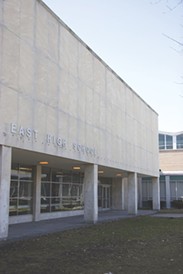News Blog
East is a bellwether for a troubled district

- FILE PHOTO
- Changes looming for East High School.
Rochester schools Superintendent Bolgen Vargas and most city school board members listened for several hours to about 70 speakers last night at East. Parents, students, teachers, East alums, education advocates, and several neighborhood leaders gave passionate accounts of the problems at East and possible solutions.
To recap: the SED has ordered Vargas to come up with a plan to fix East’s persistently low academic performance. Vargas has five options: close the school; phase out East and gradually open a new school; covert East to a charter; turn the school over to SUNY to manage; or align the school with an educational partner organization.
Vargas has sent out feelers to the business and educational communities regarding the EPO option. He’s also stated that he won’t close East, and that he doesn't believe the phasing model works.
An EPO might be one of the least painful options, and State Education Commissioner John King recently hinted that he favors an EPO, too.
But King envisions an EPO similar to Pathways in Early Technology High. P-Tech is a venture formed in a troubled Brooklyn school between IBM, City University, and the New York City school system. And it has received loads of attention from politicians and educators throughout the country. Governor Andrew Cuomo said earlier this year that he wants to start 10 more P-Tech style schools throughout the state.
P-Tech is a six-year program that starts with students in ninth grade. Students earn a technology-based associate degree upon graduation. The degree is essentially tuition free, since technically the students are still in high school.
But it’s a little early to rave about P-Tech’s results. And even though many of last night's speakers said they like the EPO option, they have something else in mind. Many said they want Vargas and the board to be assertive and recommend a local partnership consisting of local educators.
Though standing up to the SED is not an option, some of the speakers raised an extremely important point: just how successful are the five SED-provided options? Where’s the evidence that these models are effective?
While some speakers said that the education departments at local colleges and universities have the talent and resources to be good partners with schools like East, others were skeptical about their track record working with urban children.
Considering the SED’s view of East’s performance, there was surprisingly little criticism of the school’s teachers and administrators. Some of the students and alums said their teachers were often the only people in their lives standing between them and disaster.
However, many at the meeting had harsh words for former Superintendent Jean-Claude Brizard. His plan for an equitable distribution of resources, some speakers said, resulted in stripping East of the counselors, programs, and support systems the struggling school needed to improve.
Perhaps the best illustration of how difficult East’s problems will be to resolve came from some of East's bilingual students. They addressed the board and Vargas in Spanish, often relying on a translator. If English is a second language for 23 percent of East’s students, and another 21 percent have special education requirements, it’s difficult to imagine the SED’s options adequately addresses East’s problems.
Vargas and the school board now have until May 15 to decide what kind of plan for fixing East they’ll send to the SED for approval. The state gave the district an extension from the original deadline, which was the end of this month. But whatever happens at East may be an indication of what may happen with a slew of other low-performing city schools.
Board President Van White reminded those who attended the meeting that a disagreement with the SED about a plan for East could result in the state appointing someone from Albany who will remove the school from local control. Some in the audience welcomed the challenge, given Albany’s luminous history of problem-solving.